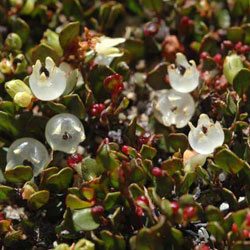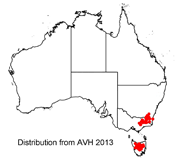Muehlenbeckia axillaris
 |
 |
Matted Lignum
Muehlenbeckia axillaris (Hook.f.) Endl.
Muehlenbeckia axillaris is a prostrate shrub. It is a climber which forms a dense mat up to 40 cm in height and 1m in diameter. Muehlenbeckia are members of the Polygonaceae family. Of these Muehlenbeckia species, 17 are currently found in Australia.
 M. axillaris is a montane shrub, found at a wide range of altitudes up to 1200m and is distributed along the length of the Australian Alps, through New South Wales, the ACT and Victoria. It is also found in the central highlands of Tasmania and in the Southern Alps of New Zealand’s South Island.
M. axillaris is a montane shrub, found at a wide range of altitudes up to 1200m and is distributed along the length of the Australian Alps, through New South Wales, the ACT and Victoria. It is also found in the central highlands of Tasmania and in the Southern Alps of New Zealand’s South Island.
It has small, dark green, ovate-oblong leaves which grow alternately along the length of dark red-brown stems. The flowers are small, around 0.5cm in diameter and have a yellowish white colour. The fruit takes the form of a three-pointed dark brown achene. The fruit is surrounded by the swollen perianth, which is fleshy, white and much larger than the achene.
As it doesn’t reach any significant height and grows as a thick mat, it is a good choice for ground cover in the garden. M. axillaris prefers full sun and a well drained, rocky soil. For this reason, while in can be used to cover a bare area of ground, it is much more suited as a plant for rockeries. Its abilities as a climber can also be used within the garden.
M. axillaris is slow growing in its natural alpine conditions but thrives in warmer climates. It can be propagated from both seed and cutting. It is often easier to grow from cuttings as the cuttings require very little propagating hormone for them to establish successfully. Cuttings should be taken from growth that is at least a year old, if not, the stem is too moist and propagation will not be successful. By using a propagation medium of 5 parts perlite to 1 part coir, a well drained medium for growth can be created.
It has the ability to overwhelm smaller plants in its general vicinity and spreads underground using shoots. While this means that it can be used to help control weeds in a garden, it can also spread into areas where it is unwanted.
Chris Flood, Botanical Intern 2013
Name meaning: Muehlenbeckia axillarisMuehlenbeckia – after H. G. Muehlenbeck, a 19th century French physician axillaris – meaning borne in the axil, referring to the position of the flowers in the axils of the leaves |
References:
Harden, G. J. (editor) (1990). Flora of New South Wales. University of NSW Press, Kensington.
Elliot, W. R. and Jones, D. L. (2000). Encyclopaedia of Australian Plants Suitable for Cultivation Volume 6. Lothian Books, Port Melbourne, Australia.
Clarke, I. and Lee, H. (2009) Name That Flower. Carlton, Melbourne University Press.
Crowe. A. (2004). Native Edible Plants of New Zealand. Penguin Books (NZ), Auckland.
![An Australian Government Initiative [logo]](/images/austgovt_brown_90px.gif)

